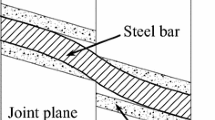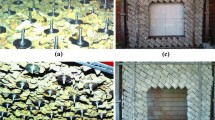Abstract
Rock reinforcement and surface support are typical components of ground support systems. Analytical design approaches tend to treat the ground support elements independently and do not explicitly consider the mechanical interaction between surface support and reinforcement. Empirical approaches consider their performance as a system, and do not provide guidance on the mechanical behaviour of the individual components. This paper focuses on gaining a better understanding of the reinforcement surface support interaction by combining the results from laboratory tests with advanced numerical modelling. A series of calibrated 3D distinct element method (DEM) models were constructed to emulate the mechanical behaviour of mesh in the laboratory. The developed 3D DEM models provided further insight into the impact of bolt spacing in diamond and square bolting patterns. Longer spacing between bolts provided a more ductile material response and lower load at initial wire failure. Modification to bolt spacing has a more significant influence on mesh displacement than load capacity. An increase in bolt spacing results in a substantially larger increase in the displacement when a square arrangement of bolts is used and a relatively larger load reduction when a diamond arrangement is used. Square patterns consistently provided a more ductile response with higher loading capacity at initial wire rupture than diamond patterns for the same bolt density. These results can be used in the design of rock bolting strategies under different ground conditions.






















Similar content being viewed by others
Data Availability
All data used are clearly indicated in the manuscript.
Code Availability
The numerical code used is commercially available from Itasca.
References
Baek B, Karampinos E, Hadjigeorgiou J (2020) Understanding the impact of test configuration on welded-wire mesh laboratory test results. Rock Mech Rock Eng 53(11):4873–4892
Bertrand D, Nicot F, Gotteland P, Lambert S (2008) Discrete element method (DEM) numerical modelling of double-twisted hexagonal mesh. Can Geotech J 45(8):1104–1117
Coates DF (1981) Rock mechanics principles: energy, mines and resources. Mines Branch, Government of Canada, Ottawa
Dolinar D (2006) Load capacity and stiffness characteristics of screen materials used for surface control in underground coal mines. In: Proceedings of the 25th International Conference on Ground Control in Mining, Morgantown, pp 152–158
Grimstad E, Barton N (1993) Updating the Q-system for NMT. In: Kompen C, Opsahl SL, Berg SL (eds) Proceedings of the International Symposium on Sprayed Concrete, Norwegian Concrete Association, p 21
Hadjigeorgiou J, Stacey TR (2018) Challenges in determining the capacity of mesh. In: Proceedings of the Fourth Australasian Ground Control in Mining Conference, Sydney, pp 280–290
Itasca Consulting Group Inc (2016) 3DEC-Theory and background. Itasca Consulting Group Inc, Minneapolis
Karampinos E, Hadjigeorgiou J (2021) Quantifying the impact of bolting patterns on the performance of welded wire mesh. Geotech Geol Eng 39:359–376
Karampinos E, Hadjigeorgiou J, Turcotte P (2016) Discrete element modelling of the influence of reinforcement in structurally controlled squeezing mechanisms in a hard rock mine. Rock Mech Rock Eng 49(12):4869–4892
Morton E, Thompson A, Villaescusa E, Roth A (2007) Testing and analysis of steel wire mesh for mining applications of rock surface support. In: Olalla C, Grossman N, Ribeiro e Sousa L (eds) Proceedings of the 11th Congress of the International Society for Rock Mechanics, Taylor & Francis, London, pp 1061–1064
Ortlepp W (1983) Considerations in the design of support for deep hard-rock tunnels. In: Proceedings of the 5th ISRM Congress, International Society for Rock Mechanics, Melbourne.
Potvin Y, Hadjigeorgiou J (2016) Selection of ground support for mining drives based on the Q-system. In: Nordlund E, Jones TH, Eitzenberger A (eds) Proceedings of the 8th International Symposium on Ground Support in Mining and Underground Construction, pp 1–16
Roth A, Cala M, Brändle R, Rorem E (2014) Analysis and numerical modelling of dynamic ground support based on instrumented full scale tests. In: Hudyma M, Potvin Y (eds), Proceedings of the Seventh International Conference on Deep and High Stress Mining, Australian Centre for Geomechanics, Perth, pp 151–164
Simser, BP (2007) The Weakest link - ground support observations at some Canadian shield hard rock mines. In: Y Potvin (ed.), Proceedings of the Fourth International Seminar on Deep and High Stress Mining, Australian Centre for Geomechanics, Perth, pp 335–348
Tannant D (1995) Load capacity and stiffness of welded-wire mesh. In: Proceedings of the 48th Canadian Geotechnical Conference, Vancouver, pp 729–736
Thoeni K, Giacomini A, Lambert C, Sloan SW, Carter JP (2014) A 3D discrete element modelling approach for rockfall analysis with drapery systems. Int J Rock Mech Min Sci 68:107–119
Thompson A (2004) Rock support action of mesh quantified by testing and analysis. In: Potvin Y, Stacey T, Hadjigeorgiou J (eds) Surface Support in Mining. Australian Centre for Geomechanics, Nedlands, pp 391–398
Underground DSI (2017) Mining and Tunnelling Products. DSI Underground, Riverton
Xu C, Tannant D, Zheng W (2019) Discrete element analysis of the influence of bolt pattern and spacing on the force-displacement response of bolted steel mesh. Int J Numer Anal Meth Geomech 43(12):2106–2125
Xu C, Tannant D, Zheng W, Liu K (2020) Discrete element method and support vector machine applied to the analysis of steel mesh pinned by rockbolts. Int J Rock Mech Min Sci 125:104163
Acknowledgements
The financial support of the Natural Sciences and Engineering Research Council of Canada is acknowledged. At the beginning of this work, Dr. Jim Hazzard of Itasca Consulting Group, Inc. provided significant technical input, and his support is greatly acknowledged. The authors acknowledge the useful suggestions and input from Brad Simser of Glencore.
Funding
This research work was supported by the Natural Sciences and Engineering Research Council of Canada.
Author information
Authors and Affiliations
Contributions
Gained a better understanding of the reinforcement surface support interaction by combining the results from laboratory tests with advanced numerical modelling. Variations in bolt density have a higher impact on the displacement than the applied load in the mesh at initial wire failure. Modifying the bolt density has a limited impact on the energy absorption of mesh in diamond bolting patterns but a significant effect in square bolting patterns. For the same bolt density, a square bolting pattern provides a more ductile response and an increased loading capacity and energy absorption than a diamond bolting pattern.
Corresponding author
Ethics declarations
Conflict of interest
The authors declare that there is no conflict of interest.
Additional information
Publisher's Note
Springer Nature remains neutral with regard to jurisdictional claims in published maps and institutional affiliations.
Rights and permissions
About this article
Cite this article
Karampinos, E., Hadjigeorgiou, J. The Influence of Bolt Density on Welded Wire Mesh Performance. Geotech Geol Eng 40, 3711–3733 (2022). https://doi.org/10.1007/s10706-022-02127-4
Received:
Accepted:
Published:
Issue Date:
DOI: https://doi.org/10.1007/s10706-022-02127-4




